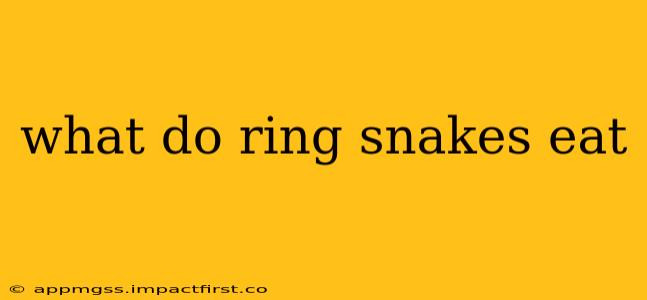Ring-necked snakes, with their elegant appearance and docile nature, are a fascinating species to observe. But what exactly do these slithery creatures consume? Understanding their diet is key to appreciating their role in the ecosystem and ensuring their well-being. This comprehensive guide dives deep into the feeding habits of ring-necked snakes, answering common questions and dispelling any myths.
What is the primary food source for ring-necked snakes?
The primary food source for ring-necked snakes is earthworms. These readily available invertebrates form the cornerstone of their diet. Ring-necked snakes are highly skilled at locating and consuming earthworms, often using their keen sense of smell and subtle vibrations in the soil to detect their prey. They're not picky eaters when it comes to earthworms, readily consuming various species.
Do ring-necked snakes eat slugs and snails?
While earthworms are their primary food source, ring-necked snakes are also known to supplement their diet with slugs and snails. These soft-bodied invertebrates provide a readily available source of nutrition, especially in environments where earthworms may be less abundant. Their ability to consume these shelled creatures reflects their adaptable feeding strategies.
What other small creatures do ring-necked snakes eat?
Beyond earthworms, slugs, and snails, ring-necked snakes have a broader diet than you might initially think. They are also known to consume:
- Salamanders: Small salamanders are a significant part of the diet for some ring-necked snake populations.
- Small frogs and toads: These amphibians provide another source of protein and moisture.
- Insect larvae: While less frequent, they may opportunistically consume insect larvae they encounter.
- Other invertebrates: Other small invertebrates such as spiders and centipedes may occasionally be part of their diet.
It's important to note that the specific diet of a ring-necked snake can vary depending on its geographic location and the availability of prey. Their adaptable nature allows them to take advantage of the most abundant food sources in their environment.
How do ring-necked snakes hunt?
Ring-necked snakes are primarily ambush predators. They patiently wait for their prey to come within striking distance, then swiftly seize it with their jaws. Their slender bodies allow them to navigate through leaf litter and soil, providing excellent cover for hunting. They are also skilled at detecting the vibrations produced by their prey moving through the soil or leaf litter.
Are ring-necked snakes venomous?
No, ring-necked snakes are non-venomous. They subdue their prey using constriction and then swallow it whole. They pose no threat to humans, and their bite is harmless.
What are the nutritional benefits of the ring-necked snake's diet?
The varied diet of a ring-necked snake provides them with essential nutrients necessary for survival and reproduction. Earthworms, slugs, snails and other invertebrates are rich in protein, essential for building and repairing tissues. The moisture content in their prey also contributes to their hydration.
How does the ring-necked snake's diet impact its habitat?
The ring-necked snake plays a vital role in maintaining the balance of its ecosystem. By consuming earthworms, slugs, snails and other invertebrates, they help regulate the populations of these organisms. This helps prevent any single species from becoming overpopulated, contributing to the overall health and biodiversity of their habitat.
This detailed exploration of the ring-necked snake's diet demonstrates their adaptability and ecological significance. Understanding their feeding habits provides further appreciation for these fascinating reptiles and their crucial place within the larger natural world.
